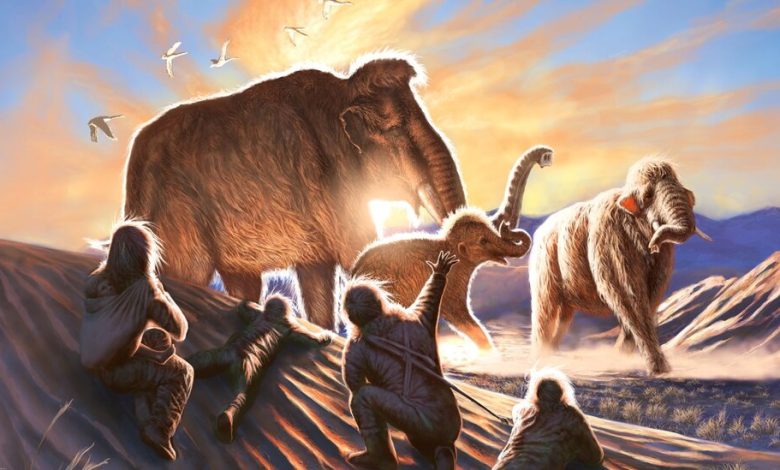An Ancient Woolly Mammoth Left a Diary in Her Tusk

Scientists have written the biography of a 14,000-year-old female woolly mammoth by analyzing the chemicals in her tusk.
The animal, nicknamed Elma, was born in what is now the Yukon and stayed close to her birthplace a decade before moving hundreds of miles west into central Alaska, the study found. There she remained until she reached about 20, when she was most likely taken down by hunters.
Scientists are beginning to tell such ancient stories by looking at the layers of minerals that once accumulated each day on the outside of the tusks of mammoths and mastodons. As researchers study more tusks, they hope to settle some of the biggest questions about how the hulking mammals thrived for hundreds of thousands of years. They are also gathering clues to how mammoths and mastodons became extinct at the end of the Ice Age — perhaps with some help from humans.
“There are answers out there,” said Joshua Miller, a University of Cincinnati paleoecologist who was not involved in the new study but who has cut open a mastodon tusk in Indiana. He said it would be necessary to look at many tusks that spanned thousands of years.
“We’re just starting to build it,” Dr. Miller said, “and that’s exciting.”
Woolly mammoths grew their tusks much like living elephants do. Each day, a thin, cone-shaped layer of minerals built up on the tip.
“I like to describe it as ice cream cones stacked on top of each other,” said Matthew Wooller, director of the stable isotope facility at the University of Alaska Fairbanks.
Much like tree rings, the cones remained fairly distinct even after the animal died. Researchers started analyzing this chemical record in the 1980s, gaining clues about how baby mammoths weaned from their mothers and how their diet changed with the seasons.
More recently, Dr. Wooller and his colleagues figured out how to use mammoth tusks to track where the animals lived over the course of their life. They did so by measuring strontium, an element found in trace amounts in the plants the animals ate. If a mammoth spent a day grazing somewhere with a lot of strontium in the soil, the cone of minerals it grew that day would have a high level of strontium.
In a 2021 study, Dr. Wooller and his colleagues analyzed the strontium in a tusk of a 17,100-year-old male mammoth. Kik, as they nicknamed the animal, died far above the Arctic Circle when he was 28. The scientists cut open one of his eight-foot-long tusks with a huge band saw.
The layers at the tip of his tusk had strontium levels that matched the site where he had been unearthed. The researchers then looked at a layer formed a week before his death and searched a geochemical map for places where Kik might have been that had a matching strontium level. The team worked back through time, week after week, piecing together Kik’s whereabouts over the course of his life.
As it turned out, Kik grew up far from the northern reaches where he met his end. When he was a young mammoth, he followed his herd around eastern Alaska. In his adult years, Kik moved widely across central Alaska. And in the last 18 months of his life, he ended up on the north side of the Brooks Range, where he likely died of starvation.
In the new study, published on Wednesday in the journal Science Advances, Dr. Wooller and his colleagues examined Elma’s six-foot-long tusk. Unlike Kik, her remains were found by Chuck Holmes, an archaeologist at the University of Alaska Fairbanks, at the Swan Point archaeological site in Alaska. While Kik died far from people, Elma’s remains ended up in a hunting and fishing camp; she may have been the victim of a hunt.
Exactly when people first arrived in North America is still an open question. But Swan Point, dating back 14,000 years, is the oldest unequivocal archaeological site in Alaska.
By the time people camped there, woolly mammoths had been in North America for about 100,000 years. During the Ice Age, they thrived on the dry grasslands north of the glaciers. But as the Ice Age drew to a close, bogs and shrubs began encroaching on their habitat.
After humans arrived in Alaska, they overlapped with woolly mammoths for about 1,000 years before the animals went extinct there. Woolly mammoths also vanished from Siberia, surviving for a few thousand more years on remote islands. Scientists have long debated whether climate changes or humans drove these extinctions.
Elma started out in life far to the west of Kik’s range, the researchers found. Later, her herd migrated east. “Maybe resources dried up there, and it just spent a while trying to find another preferable area to live in,” said Audrey Rowe, a graduate student at the University of Alaska Fairbanks who cut open Elma’s tusk.
Like Kik, Elma tended to stick to high-altitude grasslands. In fact, Elma ended up spending her final years in the same region where Kik had roamed as a young adult 3,000 years before.
Elma’s journey also took her near people. “She spent the last few years of her life wandering around in an area that happened to have evidence for some of the earliest archaeological sites,” Dr. Wooller said. “So then we started to connect the dots.”
After consulting with the Healy Lake Village Council, an organization of Indigenous people who live in the Swan Point region, the researchers hypothesized that early Alaskans searched the landscape for places with woolly mammoths and bison. “If they’re there year-round, that is like gold to an early hunter-gatherer,” said Benjamin Potter, an archaeologist at the University of Alaska Fairbanks who was also on the team.
As the Ice Age came to an end, woolly mammoths like Elma and Kik might have become easier to find because they had smaller stretches of grassland on which to graze. To Ms. Rowe, this combination of climate change and hunting may explain why woolly mammoths disappeared from Alaska when they did.
“In Alaska, mammoths would have gone extinct anyway regardless if humans were hunting them or not,” she speculated. “If anything, humans just hastened their demise.”




